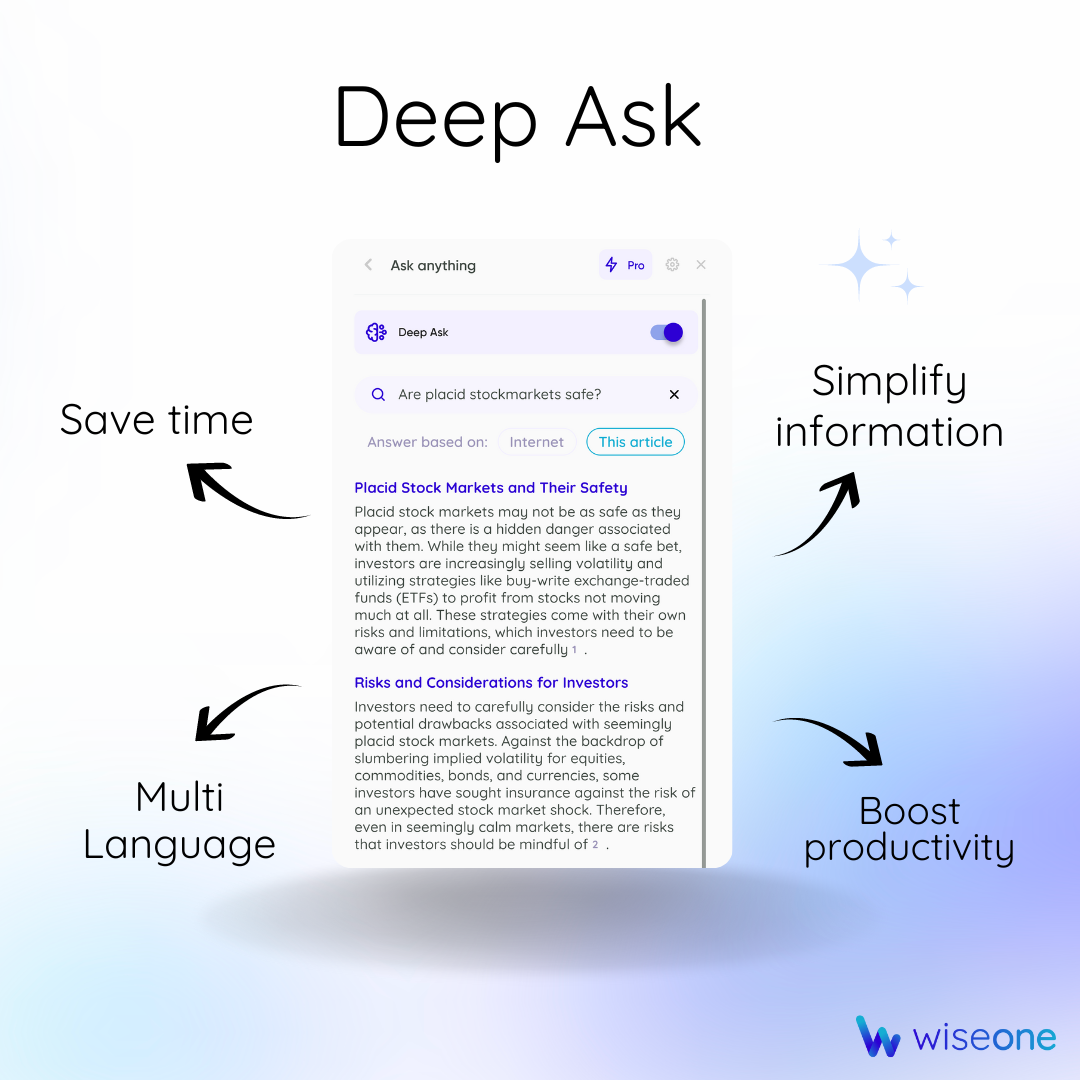How to break down complex information

Encountering complex information is an inevitable reality.
Whether you're delving into familiar topics or exploring new ones, the pervasiveness of online reading means we're constantly bombarded with online content.
Picture yourself filtering through an article full of unfamiliar information, a situation all too familiar to many of us. Regardless of our expertise, this challenge knows no boundaries, leaving readers from diverse backgrounds grappling with overwhelming frustration.
It's safe to say navigating through information demands time and effort, even for the most productive people.
As professionals, we're accustomed to mastering our respective domains, but confronting complexity in written form can be challenging.
Yet, it underscores the importance of sharpening our ability to decipher and digest complex information, which will ensure that we remain ahead.
Strategies to break down complex information
The ADEPT approach
The ADEPT Method for learning is a practical approach to improving brain power and grasping complex concepts. It involves using specific techniques to facilitate understanding and memory retention. The method consists of five key steps:
- Starting with an analogy.
- Thinking with both sides of the brain through a diagram.
- Using examples to experience the idea.
- Describing the concept in plain language.
- Converting the comprehension into a technical description.
This method aims to make learning more accessible and more effective by engaging logical and creative thinking processes.
1-Start with an Analogy
The ADEPT method suggests finding an analogy to explain a new concept. The analogy should relate the new information to something the learner already knows, which helps make the new concept more relatable and understandable.
An example provided is a computer's hard drive to a library. A computer's hard drive is like a library. It stores digital data similar to how a library stores books. Each file on the hard drive is like a book in the library, organized for easy access by the computer's operating system, acting as the librarian.
2-Using Diagram for visualization
The method recommends using diagrams to visualize and understand complex and abstract ideas. Using diagrams enables one to process information visually and improves grasping ofcomplex concepts that may be challenging to describe in words alone.
3-Experience the idea by using an Example.
The ADEPT Method emphasizes using examples to experience and understand a concept. Encountering real-life instances of the concept allows for a deeper understanding and the formation of personal connections.
It is suggested that seeking out or attempting to figure out examples helps the mind to learn through direct experience, leading to a firmer grasp of the concept.
4-Describe the concept in Plain language.
The Method also encourages explaining concepts in plain language. It involves simplifying explanations to a level that a 5-year-old could understand. The emphasis is on avoiding technical jargon and using simple, straightforward language to ensure proper concept comprehension.
5-Convert your comprehension of the concept into a Technical description
The ADEPT method's final step involves converting a concept's basic understanding into a technical description, which means being able to articulate the concept with technical terminology and details. This step aims to solidify the depth of understanding, effectively communicating the concept to others.
Mental spacing
Mental spacing refers to consistently learning concepts over a long period.
The initial part of learning a new concept is unnerving, which is why people are more likely to learn it as fast as possible. However, this only works for simple information. Focusing solely on one concept at a time is similar to honing in on a single instrument in an orchestra and drowning it in sound, neglecting the harmonious balance needed for the whole symphony to flourish.
By practicing mental spacing, individuals also become better aware of which concepts they are learning quickly and which ones they need to dedicate more time to. This helps them plan their study time more efficiently and confidently.
Feynman technique
The Feynman Technique, pioneered by the esteemed physicist Richard Feynman, offers a strategic approach to learning that challenges conventional study habits.
Feynman suggests that many people learn in a way that inadvertently prioritizes "knowing the name" of a concept instead of understanding it.
His method, based on the pursuit of understanding, contains several steps:
- Writing the information in simple, accessible language without technical jargon or consulting external resources.
- Any areas of difficulty encountered at first should be revisited, and the explanation is refined through repetition until the concept is understood.
- Simplification: this aims to simplify the explanation further while retaining its essence. This iterative approach compels to actively engage with the material, shifting away from passive absorption to active knowledge construction. A good example could be the concept of blockchain technology. Initially, one might explain it as a decentralized digital ledger used to record transactions across multiple computers. After reflection and simplification, it is a transparent, immutable record-keeping system, enhancing trust in digital transactions without intermediaries.
Through the Feynman Technique, professionals can enhance their understanding of complex concepts, transcending surface-level familiarity to achieve true mastery.
Integrating AI tools designed to break down complex information
In today's information overload era and the demanding landscape of modern professional life, dedicating hours each day to breaking down a complex concept is only possible for some.
This is where AI tools such as Wiseone come in: By leveraging their capabilities, you can integrate learning into daily routines.
Wiseone is designed to help you manage your learning efficiently. It fits into our busy schedules and helps us stay on top of our priorities without adding extra stress.
What is Wiseone?
Wiseone is an AI-powered browser extension that allows individuals and professionals to improve the productivity of their search and online reading uniquely and innovatively.
The AI tool was created with the idea that we live in a world of information overload and misinformation and that a technological solution leveraged by AI will be the answer to help web users be more efficient and productive in the way they consume information online.
Every feature in the browser extension is designed to save you time, expand your knowledge, and boost your productivity using the best LLMs available today.
How to break down complex information with Wiseone
Wiseone offers 5 unique features, among them the Deep Ask feature, which is a powerful tool for breaking down complex information encountered during online reading.
With Deep Ask, you can streamline your web search by asking questions directly related to the content at hand, simplifying complex information, and providing clear, sourced answers to even the most challenging questions.
By leveraging advanced AI search capabilities, this feature, Deep Ask, empowers users to navigate the web with confidence and efficiency, ultimately enhancing their ability to break down and comprehend complex concepts.
As the author of this article, my expertise lies in content and digital marketing. When I came across a finance-related article, understanding it proved to be initially challenging. However, using Deep Ask, I entered the question I had in mind, and within seconds, I had thorough and clear answers to my question, allowing me to comprehend the issue effortlessly despite my limited background in finance.

How to get Wiseone
Getting started with Wiseone is very easy:
1- Visit the Chrome web store, download the Wiseone extension, and create an account.
2- Pin the Extension: Once installed, pin the extension to your browser to access the features.
3- Enable the extension: Click "enable Wiseone," and a quick access button will appear on the right side of your screen.
4—Choose how to access Wiseone features: You can access the features using the quick access button or directly from the extension menu.
5- Start Exploring: Go to any webpage and start using Wiseone. Whether you prefer using the quick access button or the menu, Wiseone Pro can assist you in your searches and online reading.
FAQ
How to break down complex information
Breaking down complex information is achieved by adopting several effective strategies. One approach is the ADEPT method, which involves systematically Analyzing, Defining, Explaining, Presenting, and Testing the information. Additionally, employing Mental Spacing allows for learning in a consistent, well-paced manner, prioritizing the acquisition of multiple concepts over time. Another valuable technique is the Feynman Technique, developed by physicist Richard Feynman, which emphasizes understanding concepts by simplifying explanations and iteratively refining understanding.
What does the ADEPT approach stand for?
The ADEPT Method for learning is a strategy to improve brain power and grasp complex concepts. It involves using specific techniques to facilitate understanding and memory retention. The method consists of five key steps:
- Starting with an analogy.
- Thinking with both sides of the brain through a diagram.
- Using examples to experience the idea.
- Describing the concept in plain language.
- Converting the comprehension into a technical description.
What does mental spacing mean?
Mental spacing is the practice of regularly revisiting concepts over time. Rather than rushing to learn one concept at a time, mental spacing encourages balanced learning. It helps individuals identify which concepts need more attention and plan their study time more efficiently for improved comprehension and confidence.
What does the Feynman technique stand for?
The Feynman Technique, developed by physicist Richard Feynman, introduces a strategic learning method that challenges traditional study habits. Feynman identified a common tendency among learners to focus on recognizing the names of concepts rather than truly understanding them. His technique emphasizes the importance of genuine comprehension by breaking down complex ideas into simple explanations. Individuals can deepen their knowledge and retain information more effectively by articulating concepts in straightforward language and repeating the process until a thorough understanding is achieved.
How does Wiseone's Deep Ask feature help in breaking down complex information?
Wiseone helps break down complex information through its Deep Ask feature. The feature allows users to streamline their web searches by asking questions directly on the webpage they're reading. Deep Ask simplifies complex information, and users receive clear, sourced answers to even the most challenging questions.
Enhance your web search,
Boost your reading productivity with Wiseone



